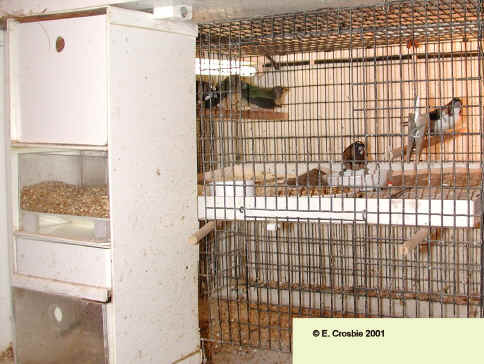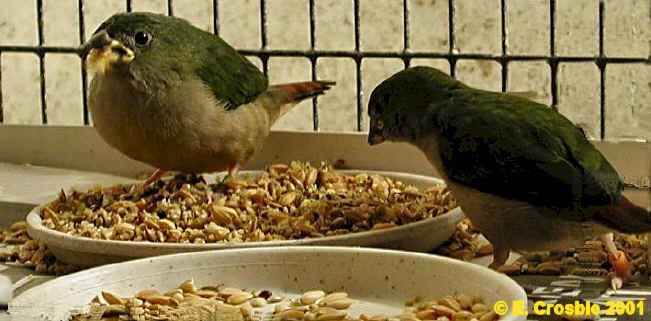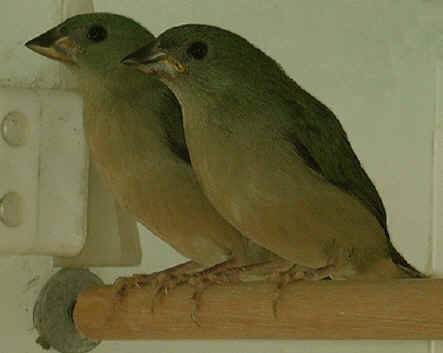A day or two before one or more Pin-tailed chicks fledge, put several layers
of paper in the floor tray. Remove perch furthest from nest
The tray should fit within the cage rather than extending out the front but, in such a way
that the chick's legs can't get trapped or broken
Now, raise the tray to about level with bottom of the nest. This keeps chicks in close
proximity to the fosters, and, they can easily get back into the nest. Important if the
Bengalese pay more attention to chicks still in the nest
Alternatively, some place the nest box on the floor after fledging, but this seems more
disruptive
A false hardboard floor also works for the few days needed if trays
are external. Watch for leg-breaking gaps
With all-wire cages, dowelling easily used as temporary tray support. For box
cages, prior to fostering, drill small holes in the cage back. Small
headless nail in end of support dowelling then fits in the hole
Lower floor - tray or false floor is lowered back in two stages
Usually left at highest point for two days If feeding going well then second perch
replaced after a day or two
If all fledglings flying from perch to perch and being fed, false floor lowered to
a mid-point, then lowered right down the next day
Speed of this process depends upon judgement as to how well chicks are doing, flying and
being fed
Keep it clean - during this process, top sheet of newspaper removed
daily
Ensures old soft food or droppings not pecked at by the fledglings as begin to explore
A day or two before fledging, put several layers of paper in the floor tray. Remove
perch furthest from nest
The tray should fit within the cage rather than extending out the front but, in such a way,
that chick's legs can't get trapped or broken
A false hardboard floor also works for the few days needed, if trays
are external. Watch for leg-breaking gaps
Alternatively, some place the nest box on the floor after fledging, but seems more
disruptive
With all-wire cages, dowelling easily used as temporary tray support. For box
cages, prior to fostering, drill small holes in the cage back. Small
headless nail in end of support dowelling then fits in the hole
Now, raise the tray to about level with bottom of the nest. This keeps chicks in close
proximity to the fosters, and, they can easily get back into the nest. Important if the
Bengalese pay more attention to chicks still in the nest
Lower floor - tray or false floor is lowered back in two stages
Usually left at highest point for two days If feeding going well then second perch
replaced after a day or two
If all fledglings flying from perch to perch and being fed, false floor lowered to
a mid-point, then lowered right down the next day
Speed of this process depends upon judgement as to how well chicks are doing, flying and
being fed
Keep it clean - during this process, remove top sheet of newspaper
daily
Ensures old soft food or droppings not pecked at by the fledglings as begin to explore











